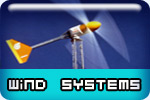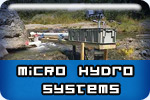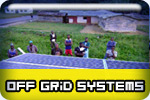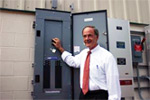Why Choose a Wise Power System, for Solar Electric?
A solar electric Wise Power System can be installed on virtually any type of roof, and will be productive if there is good southern exposure. It operates silently, produces no harmful emissions, has no moving parts, and requires little or no maintenance after installation. The modules come with the manufacturer’s 25 year limited warrantee, and Wise Power Systems stands behind every system with a five year limited warrantee. A realistic system life expectancy can exceed 30-40 years. When making an investment that will be powering your future, it is best to choose wisely. Choose a Wise Power System.
How does a Wise Power System turn sunlight into electricity?
An introduction to photons, the photoelectric effect, and photovoltaic cells…
You have probably seen those black panels on the roof of a building, and recognize them as ‘solar panels’, but what exactly are they, anyway? What you have actually seen is a solar array, which is a group of photovoltaic panels – called modules – linked together to work as a single power generating system. The modules are comprised of photovoltaic cells. Photovoltaic (PV) cells are the building blocks of solar electric energy production.
The word photovoltaic comes from the Greek root phos-, meaning light, and the word volt, which is a unit of electrical measurement, named for the inventor of the electric battery, the Italian physicist Alessandro Volta. It literally means ‘light-electricity’.
PV cells are actually semi-conductor devices containing wafers of specially modified silicon. When sunlight hits the PV cells’ dark surface, some of the solar energy particles (called photons) are absorbed. The photoelectric effect is the physical process that occurs when light hits a metal surface (in this case, an interior layer of the PV cell) emitting electrons. Atoms in the PV material take on the original photon energy now transformed into electrons. The silicon in the PV cells then conducts its newly acquired surplus of electrons out to a wire, which becomes part of the direct current in an electrical circuit. The wire then connects to an inverter, which converts the D/C (direct current) into A/C (alternating current) electricity, suitable for use by your home electric systems.
This is a somewhat simplified overview of the processes of a photovoltaic system, but now, you get the general idea of what goes on in those rooftop arrays.
Maintaining Power When the Sun Doesn’t Shine…
Your Wise Power System will produce electricity on a cloudy day – however, it will not make as much as it would on a sunny day. A cloudy atmosphere deflects more of the sun’s photon energy away from your solar array, so it has less fuel for making electricity. Fortunately, this does not mean that you must sit in the dark at night, or on a cloudy day! With a Wise Power System, you have options! Why do you think we call it Wise, anyway?
The Convenience of Net-Metering and a Grid-Tied System
Net-Metering is the arrangement between a utility supplier, and its customers who generate electricity with their own renewable energy systems. When a home (or commercial) system meets the utility company’s electrical standards – as a Wise Power System does – then the connection between your meter and the grid becomes a two-way street. In other words, the utility company will buy any surplus electricity you generate as your system pushes it out onto the grid. Your meter will spin backwards, and you will receive credit on your bill for the electricity you supply. At night, or in dim weather, when you are consuming more electricity than your system is producing, you draw electricity from the grid. In essence, you are using the power grid like a huge battery storage unit for your system! Typically, the utility companies allow you to carry credits forward if you produce more than you buy in a billing cycle. This means you might pay for your winter months’ electricity, with what you produce during the summer. A cost effective system, sized for efficiency, is one in which peak electricity production on sunny days offsets the grid supplied power used at other times.
When your system is set up to take advantage of net-metering with the local utility company, obviously, it is connected to the power grid. This is called an intertied or a grid-tied system. It is typically the most cost-effective system to purchase and use, if you already have grid connection at your location. An estimated 95% of domestic and small commercial systems in use, currently, are grid-tied systems with no battery back-up components.
Battery Back-Up for Your System
Another option for dealing with those times when sunlight is scarce is to include a battery back-up component in your Wise Power System. Battery back-up systems offer a few advantages, and still can be grid-tied, allowing you to take advantage of net-metering. Special batteries banks are charged with the D/C electricity emerging from your solar array, prior to it’s conversion into A/C at the inverter device. When the batteries are fully charged, any surplus electricity not in use in the building can be sold to the utility company, just like a system without batteries. However, during a grid power-outage, if your system is not actively producing enough electricity to meet your needs, you can use battery power to run your essential systems. While businesses that suffer significant productivity and revenue loss, and residences that suffer frequent or prolonged power outages, might wish to invest in a battery back-up system, it is not necessarily cost effective for many consumers. Batteries require additional storage space and routine maintenance, and have a shorter useful life expectancy than the rest of your system’s components. Still… in some cases, a battery back-up system might be worth the added expense. Your Wise Power Systems sales consultant will help you weigh the options, and find the right system for your needs and budget.
The Basic Components of Your Wise Power System
The Solar Array – panels of photovoltaic cells mounted with brackets on your roof, or on special feet, on the ground. They make D/C electricity from solar energy. The PV modules are available in different wattage capacity, at varying prices. The size of, and number of panels in, your solar array depends upon the available space, your energy needs and your budget.
The Inverter – is a sophisticated electronic device, with its own operating software, which converts the D/C electricity produced by your array, into A/C electricity used indoors, to run electrical appliances. It also monitors the supply of electricity generated by the array, and the voltage and frequency coming from the grid, so the power supplies are compatible for inter-change. In a grid-tied system, the inverter switches off during power outage, for safety reasons (so utility line workers will not be electrocuted by your system’s electricity, for example).
The D/C and A/C Disconnect Devices – these are emergency disconnects on either side of the inverter component. They stop the flow of direct current heading into your inverter, and the alternating current heading out of it, before it reaches your building’s main electrical panel, or the power grid.
The Indoor System Monitor Display – sounds like what it is – a display unit (or, in some cases, a software program to run on your computer with an Ethernet connection) which supplies you with the vital statistics conveyed by your system inverter. Typically, it displays instantaneous output from your array, cumulative output from the last year of operation, and in some cases the total CO2 abatement since installation, among other relevant data points. The display allows you to check up on your system’s performance, easily, from indoors.
The Power Meter – you already have this, if you currently have a utility connection. In most cases, your existing meter will function running forward or backwards, however they typically are designed for accuracy moving forward only, so the utility company may install an up-dated bi-directional meter.
* Systems with battery back-up also must have charge controller devices to insure that the batteries do not over-charge.













